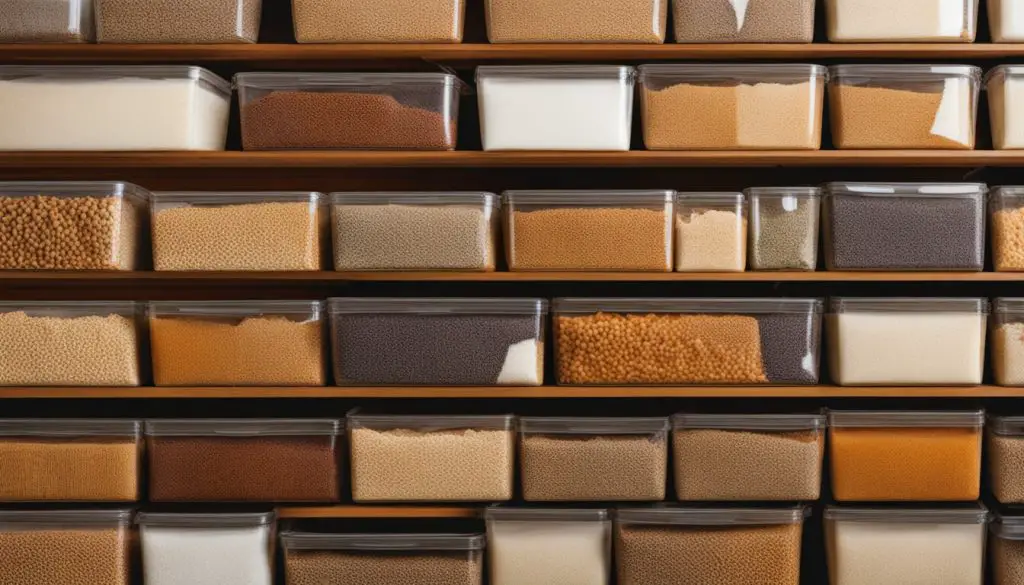
Pantry Moths: Unveiling the Silent Invaders of Your Kitchen
Imagine opening your pantry, eager to prepare a meal or grab a snack, only to be greeted by an unexpected sight – pantry moths. These tiny, fluttering invaders may seem harmless at first, but they can quickly turn your kitchen into a nightmare. In this article, we’ll delve into the world of pantry moths, revealing the silent invaders that might be lurking in your kitchen.
A Pantry Pest Nightmare
Pantry moths, often referred to as Indian meal moths, are a common household nuisance. They are small, inconspicuous insects that can infest your stored food products, turning your kitchen into a pantry pest nightmare. These moths lay their eggs in food items, and their larvae can cause significant damage by feeding on your grains, cereals, nuts, and more.
The Hidden Culprits
The tricky part about pantry moths is that they are often hidden from plain sight. They can infest your food items without you even knowing it. These pests are excellent at finding their way into unsealed packages, and their tiny size allows them to go unnoticed until the infestation becomes severe.
Why You Should Care
You might wonder why pantry moths are a cause for concern. Well, there are several reasons why you should care about these silent invaders:
- Food Contamination: Pantry moths can contaminate your food with their eggs and larvae. Consuming infested food can lead to health risks.
- Financial Loss: Infestations can result in the need to throw away food items, causing a significant financial loss.
- Kitchen Hygiene: A pantry moth infestation is a sign of poor kitchen hygiene, and it can be embarrassing when guests discover these pests in your food.
- Stress and Inconvenience: Dealing with a pantry moth infestation can be stressful and time-consuming. It’s an issue no one wants to face.
Now that you understand the importance of addressing pantry moths, let’s explore how to detect and get rid of these unwanted kitchen guests in the upcoming sections of this article.
Understanding Pantry Moths
Pantry moths, also known as Indian meal moths, are unwelcome guests in our kitchens. In this section, we’ll delve into what pantry moths are, the different species you might encounter, their life cycle, and the signs that indicate their presence.
What are Pantry Moths?
Pantry moths are small insects commonly found in kitchens and pantries. They are often mistaken for common household moths, but they have a distinct preference for infesting stored food products. These tiny pests are notorious for their ability to infiltrate unsealed packages and wreak havoc on your stored grains, cereals, nuts, and other dry goods.
The Different Species
There are several species of pantry moths, but the most common one is the Indian Meal Moth (Plodia interpunctella). This species is notorious for infesting a wide range of food items, making it a primary concern for homeowners.
The Most Common Culprits
- Indian Meal Moth (Plodia interpunctella): This is the most widespread pantry moth species. Recognizable by their reddish-brown color, these moths lay their eggs in stored grains, cereals, and pet food.
- Mediterranean Flour Moth (Ephestia kuehniella): These moths are known for infesting flour and other milled products. Their larvae can leave a web-like substance in your food.
- Almond Moth (Cadra cautella): As the name suggests, these moths target almonds, but they’re also partial to other nuts. Their larvae can cause significant damage.
- Raisin Moth (Cadra figulilella): If you’ve ever found moth larvae in your dried fruits, it’s likely the work of raisin moths.
Understanding the Moth Life Cycle
Pantry moths share a common life cycle, which consists of four stages: egg, larva, pupa, and adult. Knowing this cycle can help you effectively eliminate it.
Life Cycle of a Pantry Moth
Understanding the life cycle of a pantry moth is crucial to managing infestations. It consists of four stages: egg, larva, pupa, and adult. Here’s a brief overview:
- Egg: Adult female moths lay tiny eggs on or near food items. These eggs are hardly visible to the naked eye.
- Larva: Once hatched, the larvae are the most damaging stage. They feed on your stored food, creating webbing and leaving behind excrement.
- Pupa: Larvae eventually pupate, forming a cocoon to transform into adult moths.
- Adult: Adult moths emerge from pupae and seek out mates to start the cycle anew.
Signs of Infestation
Recognizing the signs of a pantry moth infestation is essential for early detection. Look out for these indicators:
- Tiny Moths: Adult pantry moths are small, about half an inch long, and are often seen flying near food storage areas.
- Webbing: Pantry moth larvae create silky webbing on the surface of infested food items.
- Larvae and Cocoons: You may find tiny, cream-colored larvae and pupal cocoons within food packages.
- Damage to Food: Infested food will have irregular holes and a foul odor, a result of moth larvae feeding on it.
Now that you understand what pantry moths are, their life cycle, and how to spot the signs of an infestation, it’s time to explore ways to prevent and eliminate these pests from your kitchen.
The Dangers They Pose
In this section, we’ll shed light on the significant dangers that pantry moths pose in our kitchens. From food contamination to health risks and even their psychological impact, understanding these perils is crucial for effective pest management.

Food Contamination
One of the most pressing dangers of pantry moths is food contamination. These tiny invaders lay their eggs in or near your stored food products. When the eggs hatch, the larvae begin their voracious feeding, consuming and contaminating the food. This not only results in a loss of the affected food but also spreads its presence to neighboring items. Imagine opening a bag of flour or a box of cereal only to find webs and larvae—it’s a kitchen nightmare.
Health Risks
Beyond the gross-out factor, there are health risks associated with consuming food contaminated by pantry moths. The larvae and their excrement can introduce harmful bacteria and contaminants to your food. Consuming infested food can lead to foodborne illnesses and gastrointestinal discomfort. These pests turn your pantry into a potential source of health problems, and no one wants that in their kitchen.
Psychological Impact
The presence of pantry moths can also have a significant psychological impact. The idea of tiny insects infiltrating your food can be deeply unsettling. It erodes the sense of cleanliness and hygiene in your kitchen, causing stress and discomfort. The thought of having friends or family over, only to discover pantry moths in your food, can be an embarrassing and stressful scenario.
The psychological impact extends beyond just the initial shock of discovering the infestation. It can also lead to a persistent sense of unease about food safety, which can be mentally taxing.
Understanding these dangers is essential for motivating proactive measures against pantry moths. In the following sections, we will explore methods for detecting and eliminating these pests, ensuring a safe and pest-free kitchen environment.
Identifying the Enemy
In this section, we’ll focus on identifying your kitchen’s uninvited guests—pantry moths. By understanding their physical characteristics, where to look for signs of infestation, and how to distinguish them from look-alike moths, you’ll be better equipped to combat these pests effectively.
Physical Characteristics
Pantry moths, specifically the Indian Meal Moth, have distinct physical characteristics that set them apart:
- Size: Adult pantry moths are small, measuring about half an inch in length. They are typically brown or gray, with a colorful band of reddish-brown or copper on their wings.
- Antennae: One of the key features is their distinctive, long, and thread-like antennae. These antennae are quite noticeable and set them apart from common household moths.
- Wings: Their wings are narrow and elongated, with the characteristic coloration mentioned above. When at rest, they fold their wings over their bodies, resembling a small, elongated triangle.
Where to Look
Pantry moths primarily dwell in your kitchen and pantry, but they can sometimes venture into other parts of your home. To identify their presence, focus on the following areas:
- Food Packages: Check stored food items, especially grains, cereals, nuts, and flour, for signs of infestation. Look for webbing, larvae, or cocoons inside the packaging.
- Pantry Shelves: Examine pantry shelves and cracks for any signs of webbing or larvae. Pay attention to corners and hidden spots where these pests may be hiding.
- Other Rooms: While less common, pantry moths can occasionally be found in other rooms. Check for their presence in areas where dry food items are stored, such as pet food.
Tricky Moth Look-Alikes
Pantry moths have some lookalikes, which can complicate identification. One of the most common look-alike moths is the clothes moth. To distinguish between the two:
- Habitat: Clothes moths prefer to infest fabrics and textiles, while pantry moths focus on stored food products.
- Physical Features: Clothes moths have broader, fuzzier wings, and they lack the reddish-brown or copper bands found on pantry moths.
Identifying pantry moths accurately is essential for initiating proper pest management. In the upcoming sections, we will explore detection methods and effective strategies to eliminate these pests from your kitchen.
The Moth’s Secret Arsenal
In this section, we’ll unveil the secret arsenal of pantry moths, shedding light on their fascinating mating habits, reproductive capabilities, and survival strategies.
Mating Habits
Pantry moths have intriguing mating habits that play a pivotal role in their life cycle. These habits are essential for their survival as a species. Here’s a glimpse into their mating rituals:
- Pheromone Attraction: Adult male moths release pheromones to attract females. These chemical signals are species-specific, ensuring that only female pantry moths are drawn to the scent of males of the same species.
- In-Flight Mating: Mating typically occurs during flight. Male moths locate and pursue females in the air, where they mate. This in-flight mating is a unique aspect of their reproductive behavior.
- Multiple Mating: Female pantry moths can mate multiple times, and a single female can lay hundreds of eggs in her lifetime. This prolific reproductive capacity contributes to the rapid growth of infestations.
Reproduction
The reproductive capabilities of pantry moths are remarkable and also a cause for concern in infestation management.
- Egg Laying: After mating, female moths lay their eggs on or near food items. These eggs are incredibly small and can be challenging to spot.
- Larval Stage: Once the eggs hatch, the larvae emerge, ready to feed on the food on which they were laid. This larval stage is the most destructive, as it can contaminate and damage stored food.
- Cocoon Formation: Larvae eventually form cocoons in which they undergo metamorphosis, transforming into adult moths.
- Short Life Cycle: The entire life cycle of a pantry moth, from egg to adult, can be as short as a few months, depending on environmental conditions. This rapid life cycle allows infestations to grow quickly.
Survival Strategies
Pantry moths have evolved several survival strategies to thrive in kitchen environments:
- Nocturnal Behavior: They are primarily nocturnal, which means they are most active at night. This behavior helps them avoid predators and increases their chances of successful mating and reproduction.
- Camouflage: Pantry moths’ coloration and resting posture help them blend in with their surroundings. When at rest, they fold their wings over their bodies, resembling dried leaves or other debris, which offers them some camouflage.
- Small Size: Their tiny size allows them to infiltrate even the smallest openings in packaging and pantries, making it challenging to keep them out.
Understanding the secret arsenal of pantry moths is crucial for effective pest management. In the following sections, we will explore methods to detect and eliminate these pests and discuss strategies for preventing future infestations.

Preventing Infestations
In this section, we will explore effective strategies for preventing pantry moth infestations. By maintaining a clean pantry, practicing proper food storage, and moth-proofing your home, you can create an environment that is uninviting to these pests. Additionally, we’ll provide some valuable recommendations from Pantry Raider to help you keep your kitchen pest-free.
Keep it Clean: Pantry Maintenance
Pantry maintenance is a critical step in preventing pantry moth infestations. Here are some key practices to keep your pantry clean and unattractive to these pests:
- Regular Cleaning: Clean your pantry shelves, floors, and corners regularly. Remove any spilled food, crumbs, or debris that can attract moths.
- Inspect Food Items: Periodically inspect your stored food items for signs of damage or contamination. Pay attention to grains, cereals, and nuts, which are prime targets for pantry moths.
- Dispose of Infested Food: If you find any food items with signs of infestation, promptly dispose of them to prevent the problem from spreading.
- Seal Cracks and Crevices: Seal any cracks or crevices in your pantry that may serve as entry points for moths. This includes gaps around baseboards and between shelves.
Effective Food Storage
Proper food storage is key to preventing pantry moth infestations. Consider these food storage practices:
- Airtight Containers: Store dry food items in airtight containers to prevent moths from accessing them. This includes items like flour, rice, and pet food.
- Refrigeration: If you have space, consider refrigerating or freezing susceptible food items to deter moths from infesting them.
- Rotate Stock: Use the “first in, first out” approach when using your pantry items. This ensures that older items are used before moths have a chance to infest them.
Moth-Proofing Your Home
To create a moth-proof home, follow these preventive measures:
- Screen Windows and Vents: Install screens on windows and vents to prevent moths from entering your home from the outside.
- Proper Lighting: Use yellow or sodium vapor light bulbs for outdoor lighting. These are less attractive to moths than traditional white light bulbs.
- Clean Clothing: If you store clothing, blankets, or fabrics, ensure they are clean before storage to deter clothes moths.
Pantry Raider’s Recommendations
Pantry Raider recommends the following additional tips to prevent pantry moth infestations:
- Regular Inspections: Conduct routine inspections of your pantry and stored food items to catch potential issues early.
- Use Moth Traps: Consider using pantry moth traps to monitor and reduce moth populations. These traps can help you detect an infestation before it becomes severe.
- Educate Yourself: Learn about the habits and life cycle of pantry moths to stay vigilant and take preventive action.
By following these practices and heeding Pantry Raider’s recommendations, you can maintain a pest-free kitchen and avoid the headaches of dealing with pantry moths.
Battling Pantry Moths
In this section, we’ll explore strategies for battling pantry moths effectively. Whether you prefer natural remedies, chemical solutions, or professional help, there are options to suit your needs. We’ll also share some success stories from Pantry Raider to inspire your battle against these kitchen invaders.
Natural Remedies
For those who prefer a more eco-friendly approach, several natural remedies can help in your fight against pantry moths:
- Diatomaceous Earth: This natural substance, made from fossilized diatoms, is an excellent choice. It works by dehydrating and killing the larvae. Simply sprinkle it around your pantry shelves and food storage areas.
- Bay Leaves: Placing bay leaves among your stored food items can help deter pantry moths due to their strong scent.
- Cloves: Similar to bay leaves, the scent of cloves is disliked by pantry moths. You can place cloves in your pantry or near food items.
- Cedarwood: Cedarwood has natural moth-repelling properties. Consider using cedar blocks or essential oil to keep moths at bay.
Chemical Solutions
If you prefer a more direct approach, various chemical solutions are available to combat pantry moths:
- Pantry Moth Sprays: There are chemical sprays specifically designed to kill pantry moths and their larvae. Follow the instructions carefully when using these products.
- Insecticides: Some general insecticides can also be effective. However, exercise caution and ensure they are safe for use around food.
- Moth Traps: Sticky moth traps with pheromone lures are a chemical-free way to monitor and reduce moth populations.
Calling the Professionals
In severe infestations or if you prefer a hands-off approach, calling professionals may be the best solution. Pest control experts can assess the extent of the infestation and implement appropriate measures to eliminate pantry moths.
Success Stories from Pantry Raider
Pantry Raider has featured several success stories from readers who have successfully battled pantry moths. These stories often involve a combination of methods, like cleaning, proper storage, and sometimes professional intervention. Here are some key takeaways from these stories:
- Early Detection: Detecting the infestation early is crucial. Many successful stories emphasized the importance of regularly inspecting stored food items.
- Thorough Cleaning: A clean pantry is a deterrent to pantry moths. Success stories often highlighted thorough cleaning and maintaining a well-organized pantry.
- Proper Storage: Using airtight containers and proper food storage practices were recurring themes in these success stories.
- Persistence: Be persistent in your efforts. It may take time to completely eradicate an infestation, so don’t lose hope.
Protecting Your Pantry
In this section, we’ll cover the essential steps to protect your pantry from future pantry moth infestations. By learning how to safely dispose of infested items, deep cleaning your pantry, and implementing monitoring and prevention measures, you can maintain a pest-free kitchen.
Safe Disposal
When dealing with a pantry moth infestation, safe disposal of infested items is crucial to prevent the problem from spreading. Follow these steps for safe disposal:
- Inspect Thoroughly: Regularly inspect your stored food items. If you notice any signs of infestation, such as larvae, webbing, or foul odors, it’s time for disposal.
- Use Sealed Bags: Place the infested items in sealed plastic bags to prevent any escaping moths or larvae.
- Dispose of Outside: Take the sealed bags outside of your home immediately to prevent any surviving moths from reinfesting your pantry.
- Deep Clean Trash Bins: After disposal, thoroughly clean your indoor and outdoor trash bins to remove any lingering pests.
Deep Cleaning
A deep cleaning of your pantry is essential to remove any remaining eggs, larvae, or pupae and create an environment less inviting to pantry moths. Here’s how to do it:
- Empty the Pantry: Remove all items from your pantry, including shelves and drawers. This allows for a more thorough cleaning.
- Wipe Down Shelves: Use a mixture of water and vinegar to clean all pantry surfaces. Pay close attention to corners and cracks where eggs or larvae may hide.
- Vacuum: Use a vacuum cleaner with a nozzle attachment to remove any remaining debris, including stray larvae or cocoons.
- Throw Away Opened Packaging: Discard any opened or damaged packaging that could still harbor pests.
- Wash Storage Containers: Clean airtight containers and storage jars before refilling them with fresh, uncontaminated items.
Monitoring and Prevention
To ensure your pantry remains pest-free, consider these monitoring and prevention measures:
- Pantry Moth Traps: Use pantry moth traps with pheromone lures to monitor and catch any adult moths that may enter your pantry.
- Regular Inspections: Continue to inspect your stored food items regularly for any signs of infestation.
- Proper Food Storage: Maintain proper food storage practices, including using airtight containers and refrigeration for susceptible items.
- Seal Cracks: Keep your pantry well-sealed by closing any gaps or crevices that could serve as entry points for moths.
- Rotate Stock: Continue to use the “first in, first out” approach for your pantry items to prevent food from becoming old and susceptible to infestations.
Moths vs. Humans: The Ongoing Battle

In the ongoing battle between moths and humans, the stakes are high. Pantry moths can wreak havoc in our kitchens, posing not only practical but also psychological challenges. However, with the right strategies, we can transform our kitchens, regain peace of mind, and ultimately emerge victorious in this war against these tiny invaders.
The Psychological Toll
The presence of pantry moths can take a considerable psychological toll on homeowners. The very thought of tiny insects infiltrating our food can be deeply unsettling. It shakes our sense of cleanliness and hygiene, turning our sanctuary—the kitchen—into a potential source of stress. The fear of having friends or family over only to discover pantry moths in your food can be embarrassing and stressful.
This psychological impact extends beyond the initial shock of discovering an infestation. It can lead to a persistent unease about food safety, which can be mentally taxing. The ongoing battle against these pests can wear on your peace of mind.
Kitchen Transformation
The battle against pantry moths often leads to a kitchen transformation. As we implement cleaning routines, proper food storage, and monitoring measures, our kitchen evolves. We adopt new habits, from routinely inspecting stored food to using airtight containers. The pantry becomes a fortress, well-sealed against any potential invaders.
This transformation also extends to our approach to food. We become more cautious by rotating stock, and using the “first in, first out” method. It’s not just about dealing with an infestation; it’s about preventing future incursions.
The Peace of Mind
The ultimate goal in this ongoing battle is peace of mind. As we adopt effective strategies and create a kitchen that is uninviting to pantry moths, we regain our sense of security and confidence. Knowing that our food is safe from contamination and that our kitchen is clean and well-protected is a source of great relief.
Peace of mind comes not only from the physical transformation of our kitchen but also from the knowledge that we have the tools and knowledge to maintain a pest-free environment.
In this battle between moths and humans, victory is not just about eradicating an infestation; it’s about ensuring lasting peace of mind in our culinary sanctuaries.
FAQs
How do I know if I have pantry moths?
Pantry moths leave telltale signs of their presence. Look for small, sometimes nearly invisible eggs on food packaging, webbing or silk threads, and larvae inside food products. Adult moths are easily identifiable when they emerge from infested items.
Are pantry moths harmful to my health?
While pantry moths themselves are not harmful to your health, their presence can lead to food contamination and potential health risks. Ingesting infested food is not advisable, as it may cause digestive discomfort.
What’s the most effective way to get rid of pantry moths?
Effectively getting rid of pantry moths requires a combination of strategies. These include safe disposal of infested items, deep cleaning of your pantry, and implementing monitoring and prevention measures. Natural remedies and chemical solutions can also be employed, and in severe cases, professional pest control services may be necessary.
Can I prevent pantry moth infestations?
Preventing pantry moth infestations is indeed possible. Regular pantry maintenance, effective food storage practices, moth-proofing your home, and consistent monitoring can deter these pests. Educating yourself about their habits and using tools like moth traps can also help in prevention.

Summary
The battle against pantry moths is a multifaceted struggle, encompassing not only practical measures but also psychological resilience. Pantry moths can take a toll on our peace of mind as they threaten the cleanliness and safety of our kitchens. This ongoing battle leads to a transformation of our culinary spaces, where cleanliness, proper food storage, and monitoring measures become the norm. Ultimately, the goal is to attain the peace of mind that comes from knowing our kitchen is a fortress against pantry moths and other invaders.
The Pantry Moth Chronicles
In “The Pantry Moth Chronicles,” we’ve explored the world of pantry moths, uncovering their life cycle, habits, and the havoc they can wreak in our kitchens. We’ve discussed their secret arsenal, including mating habits, reproduction, and survival strategies. By understanding these pests, we’re better equipped to combat them effectively.
